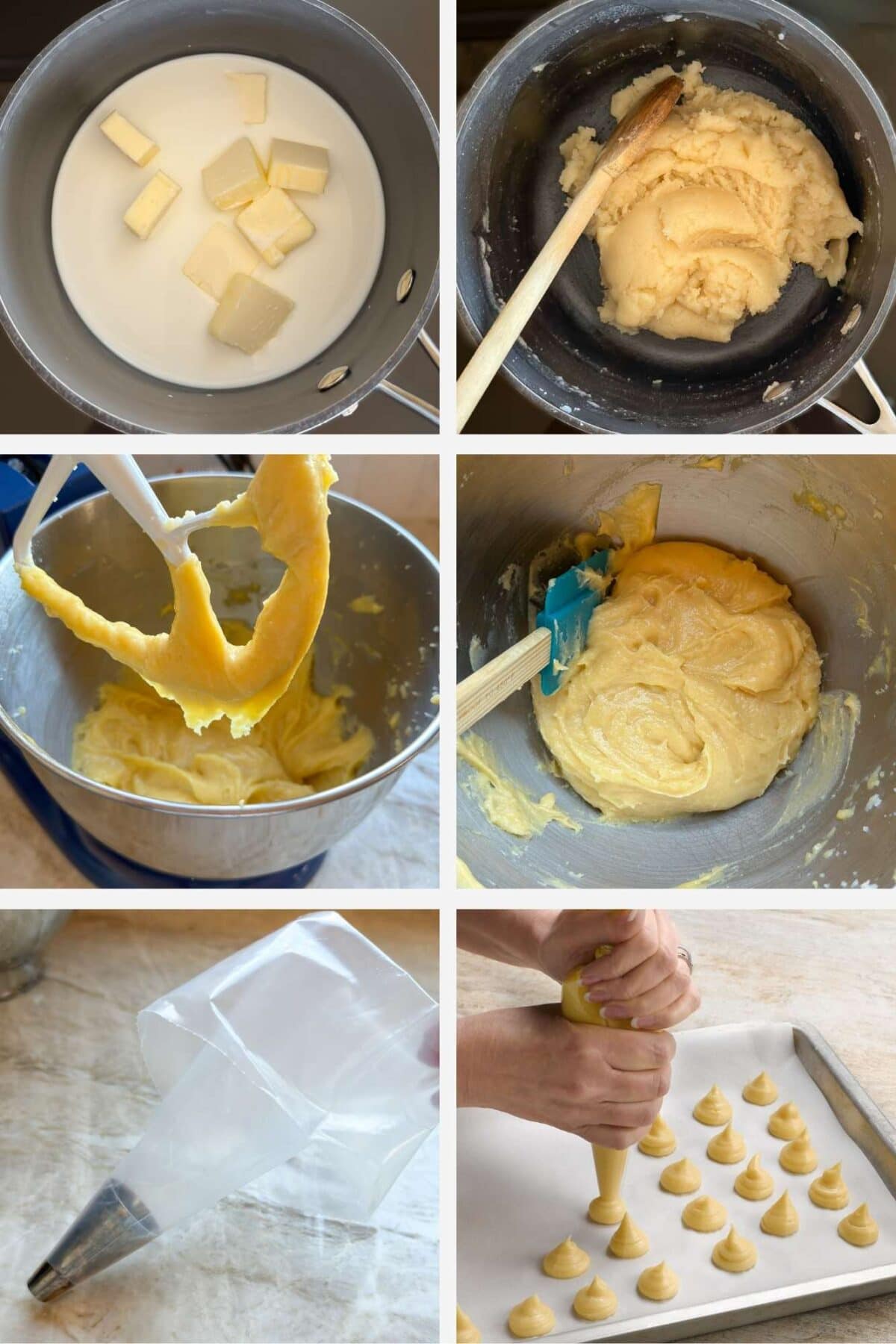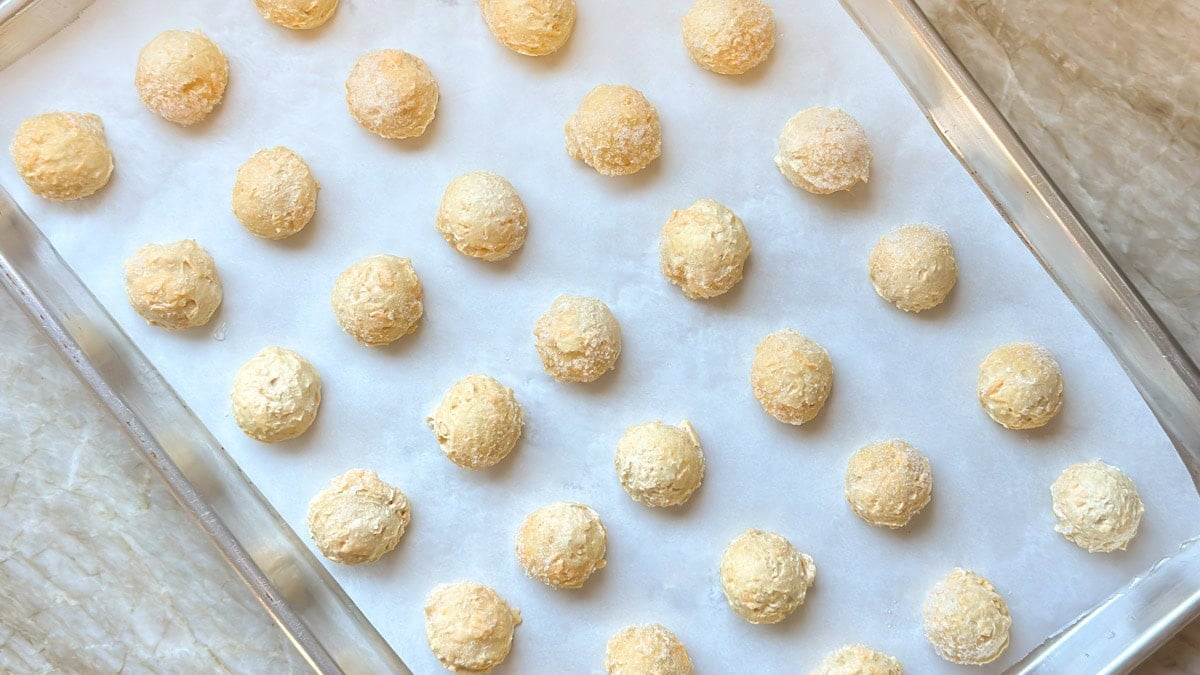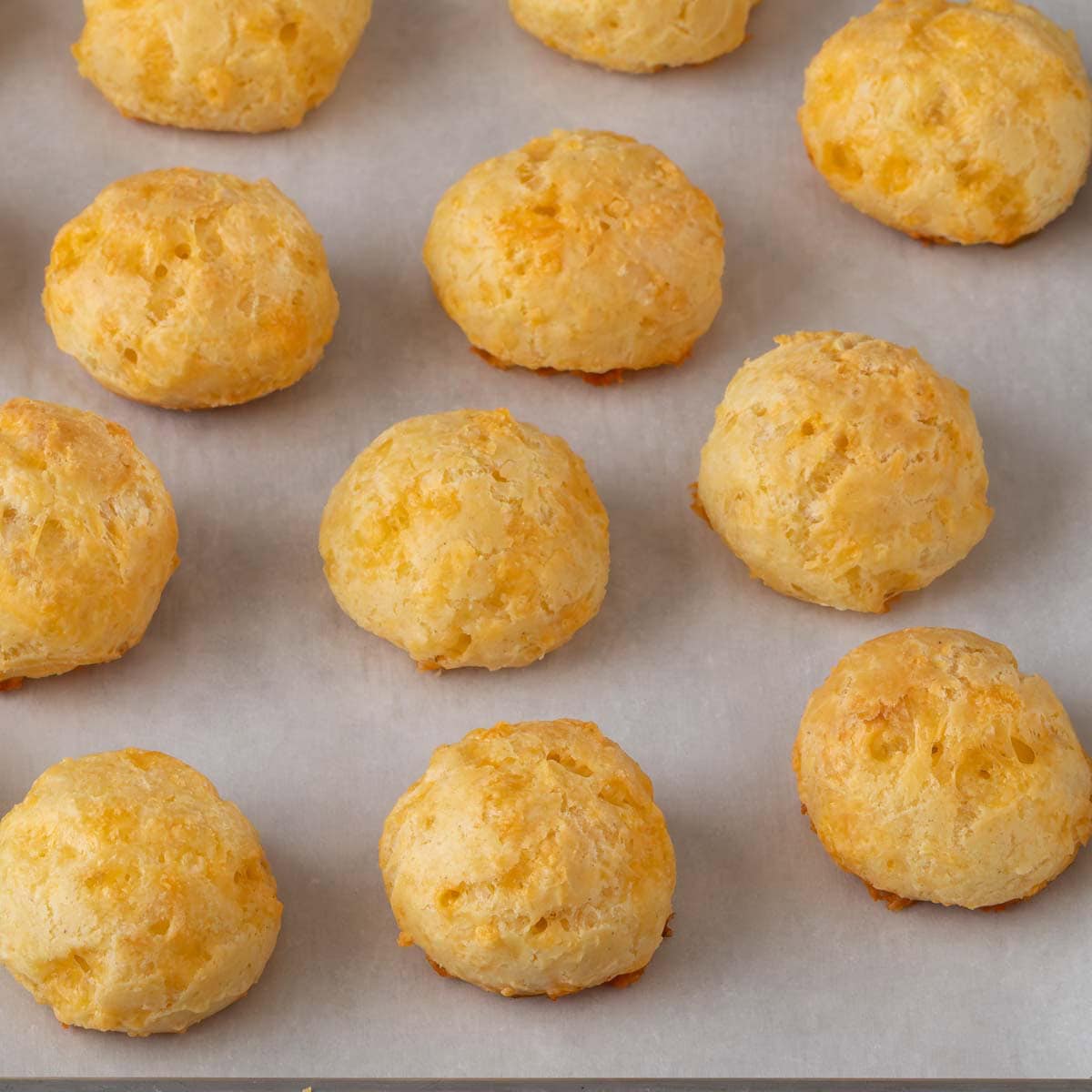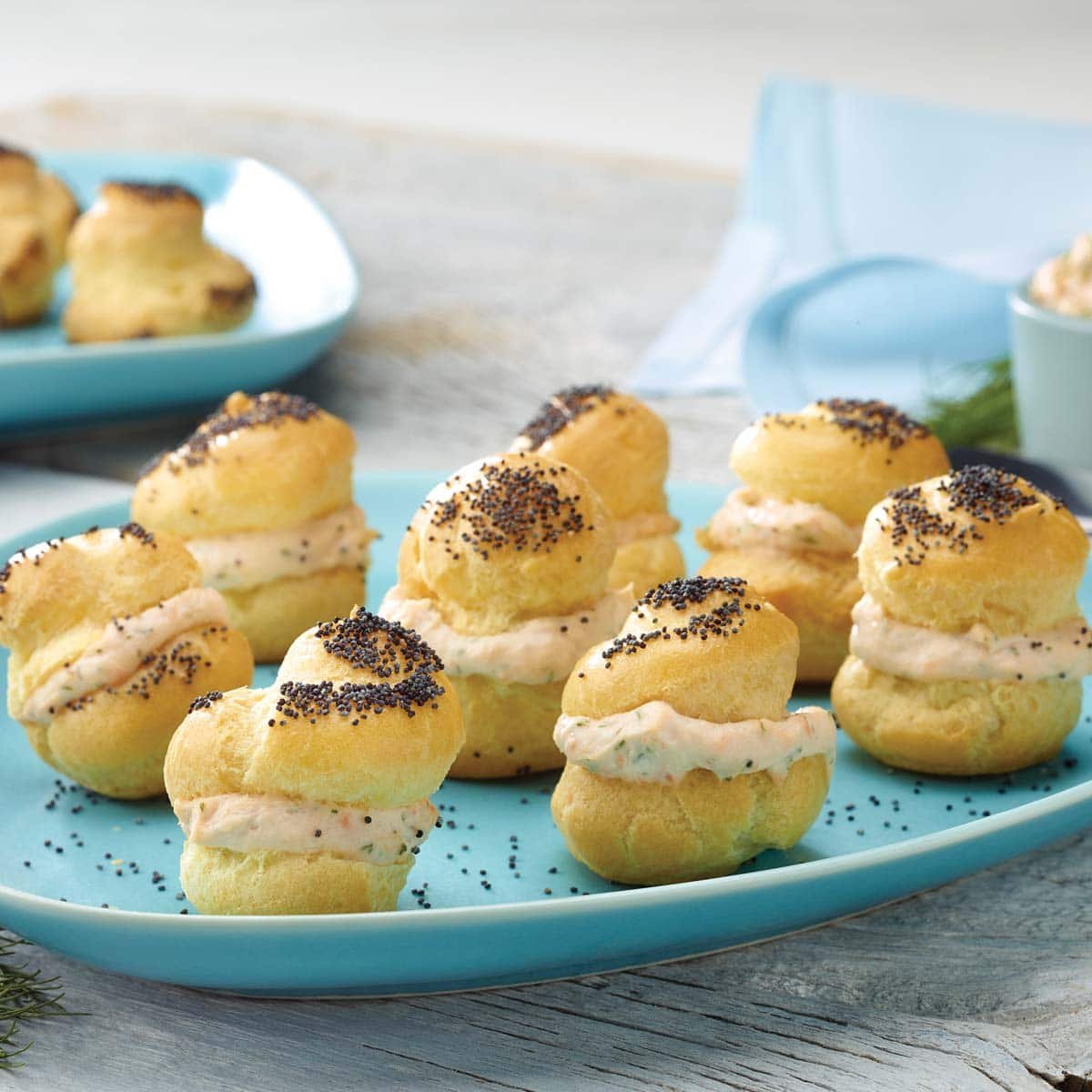Choux pastry (pâte à choux) is a classic French pastry dough that comes together in just 15 minutes, then is piped or scooped into mounds that bake into airy, hollow puffs perfect for sweet or savory fillings. In this post, you’ll find step-by-step instructions, my best tips for success, troubleshooting guidance, and specific ideas for using this versatile dough.
Note: This post contains referral links for products I recommend. As an Amazon Associate, I earn a small commission on qualified purchases, at no cost to you.
Why You’ll Love This Choux Pastry
My first experiences with choux pastry were when I was a little girl helping my mom make profiteroles. After Mom baked the choux pastry into delicate puffs with a crisp exterior and hollow center, she split them and added a scoop of ice cream. At that point my job was to put the tops back on and drizzle with chocolate sauce. Year later, once I started hosting my own gatherings, I realized how wonderfully versatile this dough is. I started experimenting with it, not just for desserts but also for elegant bite-sized appetizers, with excellent results!
Here’s why this recipe works:
- Short ingredient list – only five readily available items.
- Quick preparation – just 15 minutes of hands-on time.
- Versatility – works beautifully for both sweet and savory dishes.
- Make-ahead convenience – dough or baked puffs can both be frozen up to 1 month.
- Elegant presentation – impressive to serve yet not intimidating once you know the steps.

Choux Pastry Ingredients
This classic dough comes together with just a few everyday ingredients (scroll down to the recipe card for quantities):
- Water – Creates the steam that makes the puffs rise.
- Half and half – Adds a touch of richness and encourages browning.
- Unsalted butter – Provides flavor and helps create the dough’s structure.
- Kosher salt – Enhances the overall taste.
- All-purpose Flour – Forms the base of the dough and traps steam for the signature “puff.”
- Large eggs – Give the dough shine, elasticity, and lift.
Note on the liquid: Classic choux pastry is made with only water. I like to swap in a bit of half-and-half, which helps the puffs brown while keeping the interior light and airy.
Ingredient Variations
For a sweet application (cream puffs or profiteroles), add 2 to 3 teaspoons of granulated sugar when cooking the butter mixture.
Quick Tip
To bring eggs to room temperature quickly, place them in a bowl of warm water (90-100 degrees F) for 5-7 minutes. The water should feel warm but never hot; hot water can start to cook the eggs.
How to Make Choux Pastry

Here’s a high-level overview of the process; scan down to the recipe card for more detailed step-by-step instructions.
- Cook the dough base.
Bring the water, half-and-half, butter, and salt to a boil. Add flour and stir vigorously until the dough pulls away from the pan in a smooth ball. Cook briefly to remove excess moisture. - Beat in eggs.
Transfer the dough to the bowl of a stand mixer and beat until steam escapes. Add eggs one at a time until the dough becomes smooth, shiny, and forms a “V” when the paddle is lifted. and breaks off from the dough in the bowl. - Pipe and bake.
Pipe mounds onto parchment-lined baking sheets, flatten the tips with a moistened finger, and bake until puffed, golden, and hollow-sounding when tapped.
Note: The interior of choux puffs can vary depending on their size. Smaller puffs often bake with several small, connected air pockets, while larger puffs tend to form one main hollow center. Both structures are completely normal and perfect for filling with sweet or savory mixtures.
Keys to Successful Pâte à Choux
Successful choux pastry depends on three main factors:
- Managing moisture from start to finish.
Too much moisture can prevent proper rise and keep the centers from hollowing.
Be sure to:- Cook the flour mixture long enough to remove excess moisture.
- Release more steam by beating the dough in the mixer until the steam escapes before adding the eggs.
- Finding the proper flour-to-egg ratio.
The dough should not be too stiff or too loose. Too much flour makes the dough firm and prevents it from puffing. Too much egg thins the dough, causing it to spread when piped.
The best way to determine if you have the correct balance:- After adding the eggs, dip the paddle into the dough and lift it up. It should form a “V” shape, cleanly breaking from the dough in the bowl, hanging from the paddle, and maintaining that shape.
- Avoiding early oven opening.
Opening the oven too soon can cause the pastry shells to collapse. Wait at least 20 minutes before opening the door.
Troubleshooting Choux Pastry
- The dough is too stiff
- How to tell: It breaks off the paddle too quickly.
- Fix: Add an extra egg. Start with half an egg (beat one egg in a small bowl, then add half).
- The dough is too loose
- How to tell: It runs off the paddle and won’t hold its shape.
- Fix: Return it to a saucepan and cook over low heat for 30–60 seconds, stirring constantly, to evaporate moisture. Avoid higher heat or longer cooking to prevent the eggs from scrambling.
How to Pipe Choux Pastry
Here’s how to pipe the dough into mounds for baking:
- Fit a plain tip into a piping bag (or cut a small opening in a large zip-top bag).
- Fold the top down to form a cuff and fill the bag no more than halfway.
- Pull up the cuff and either fold over or twist the top to push the dough down into the tip.
- Point tip around 1/2 inch above where you want to pipe, guiding it with your non-dominant hand. Use your other hand to push filling from the top of the bag (where it’s twisted) out of the tip, to the desired size.
- Release pressure, give a small circular motion, and pull straight up.
Piping Tips:
- Leave at least 1 inch between puffs for good air circulation.
- Flatten pointed tops with a moistened fingertip; it adds moisture and helps any added toppings adhere.
Quick Tip
If piping feels intimidating, use a small spring-loaded scoop instead – it’s easy, quick, and the dough balls come out the same size!

How to Use Choux Pastry
Here’s how I use choux pastry to create both savory and sweet dishes:
- Poppy Seed Puffs – use a 1/2-inch tip to pipe 3/4-inch high (and wide) mounds onto prepared sheets, spaced at least 1 inch apart. Just before serving, cut in half horizontally, spoon in the desired filling, and replace the tops. I like to fill them with Smoked Salmon Mousse (see photo at top of post and in the recipe card below), our Pimento Cheese, or Country Ham Spread.
- Cheese Gougères – recipe coming soon!
- Cream Puffs or Profiteroles – Use a large tip to pipe dough into mounds about 2-3 inches high, spaced at least 2 inches apart. For cream puffs, fill with vanilla pastry cream or sweetened whipped cream. For profiteroles, fill with a scoop of ice cream and drizzle the tops with chocolate sauce.

Make Ahead and Storage
- Choux pastry dough can be made up to 3 days ahead. Place in an airtight container and refrigerate. Let it sit at room temperature until soft enough to pipe.
- You can also freeze piped dough: pipe onto a parchment-lined baking sheet, freeze until firm, then transfer to a zip-top bag. Bake from frozen, adding a few extra minutes.
- Baked choux puffs can be frozen for up to 1 month. Cool completely, place in a single layer on a baking sheet, and freeze. When frozen, place in a zip-top bag. To serve, thaw and re-crisp in a 325-degree oven for a few minutes.

How to Make French Choux Pastry (Pâte à Choux)
This choux pastry comes together in about 15 minutes and bakes into light, hollow puffs ready for sweet or savory fillings. With clear steps and reliable tips, it’s a versatile French dough you’ll use for everything from cream puffs to elegant bite-size appetizers.
- Prep Time: 15 minutes
- Cook Time: 25 minutes
- Total Time: 40 minutes
- Yield: Varies
Ingredients
- 3/4 cup water
- 1/4 cup half and half
- 1/2 cup (8 tablespoons) unsalted butter, cut into tablespoon pieces
- 1 teaspoon kosher salt
- 1 cup all-purpose flour, preferably unbleached
- 4 to 5 large eggs, at room temperature
Instructions
Prepare dough
- In a medium saucepan, bring the water, half and half, butter, and salt to a boil over medium-high heat. Cook, stirring, until butter melts.
- Add flour all at once and, using a wooden spoon, stir vigorously until well combined and the dough gathers into a ball and moves away from the side of the pan (takes just a few minutes). Keep cooking, stirring, for another minute. The dough temperature should be 165-175 degrees F on an instant-read thermometer.
- Transfer the dough to a the bowl of an electric mixer and beat at medium speed (using the paddle attachment) for about 30 seconds to 1 minute, allowing the steam to escape from the dough.
- When no more steam is coming out, keep the machine on medium speed and add the 4 eggs, one at a time, beating well after each addition, until the mixture becomes a smooth, shiny dough. Make sure each egg is fully incorporated before adding the next one. The dough may separate a bit, but that’s okay – it will come back together again by the time the last egg is incorporated.
- To test the batter, dip the paddle into the choux and lift it up – it should form a V, breaking off from the batter in the bowl, hanging off the paddle, and holding the V shape. (See troubleshooting tips below for what to do if it’s too stiff or too loose.)
Your dough is ready; use it right away or cover and refrigerate it for up to 3 days. Bring to room temperature before using.
Pipe and Bake
- Preheat oven to 400 degrees F (375 degrees F convection). Line two half-sheet pans (or other large cookie sheets) with parchment paper.
- Transfer prepared dough to a pastry bag fitted with a plain tip. Pipe into mounds of desired size, onto the prepared baking sheets; they should be at least 1 inch apart (see detailed piping instructions below).
- Using moistened fingertips, gently flatten the tops.
- Bake for 25-30 minutes or until the puffs are risen, golden brown, firm, and sound hollow when tapped on top. Don’t open the oven door before they have baked for at least 20 minutes, or they may collapse!
- Remove from oven and set aside to cool on the pans.
Notes
Note on the liquid used: A traditional choux pastry recipe will call for only water. I swap out 1/4 of the water for half-and-half, which helps the puffs brown better.
How to pipe dough: Fit a plain tip into a piping bag (or cut the corner off a gallon-size baggie). Fold the top half of the bag over the outside (like a cuff). Spoon filling into bag, no more than half full. Pull up the cuff and twist or fold the bag closed (above the filling); keep twisting/folding until the filling is visible at the tip. Point tip around 1/2 inch above where you want to pipe, guiding it with your non-dominant hand. Use your other hand to push filling from the top of the bag (where it’s twisted) out of the tip, to the desired size. Stop and move tip in a circle to disengage it from the dough. Pull straight up.
Troubleshooting Dough Consistency:
* If the dough is too stiff (breaks off the paddle too quickly), add more egg. Start with one-half egg (place one egg in a small bowl, beat to mix the yolk and white, then add half).
* If the dough is too moist (runs off the paddle and won’t hold its shape), place it in a saucepan over low heat and cook, stirring, for 30-60 seconds, to remove more moisture. Don’t cook too long or at higher heat – you risk cooking the eggs.
- Category: appetizers, desserts, tips
- Method: Bake
- Cuisine: French





